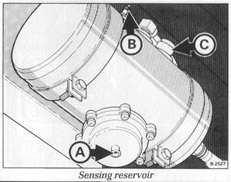Are you having problems with your brakes? If you are have a look at these pages.
If you are still having problems then contact me here for personal help.
A Bit Of Advice About Working On Dodge 50 Brakes
Brake Systems On Dodge 50 series vehicles
Hydraulic System fitted to S46,S56,S66
Compressed Air System fitted to B75 and RB75 4X4
General
The foot brake system is hydraulically operated with vacuum or air assistance to front and rear brake assemblies.
On vacuum hydraulic models the handbrake is cable operated and acts on the rear wheels only. On air hydraulic models, parking is by means of a spring brake unit which operates when air is released from the cylinder. Adjustment of brake shoe or pad clearance is made by foot brake application on the front brakes and by foot or handbrake application on the rears.
WARNING
It is important that the brake system
be maintained to a high degree of efficiency at all times.
The following notes should be observed:-
1) Regularly check all visible parts of the system for signs of leaks. Rectify
as necessary immediately.
2) Ensure that the brake fluid reservoir is kept topped up to its correct level.
3) Inspect all pipelines, brake hoses and external rubber boots for signs of
wear, damage and deterioration. Rectify as required.
4) Examine brake shoes and pads for wear at regular intervals as indicated in
the service schedule.
5) Renew the hydraulic fluid and seals as recommended in the Planned Maintenance
Schedule.
A load-sensing valve is incorporated
which regulates the braking effort applied at the rear wheels relative to the
load on the rear axle.
The system also incorporates warning lights for handbrake 'on', hydraulic brake
fluid low level and low vacuum/air. (See "Brake Warning Light and Buzzer").
AIR
SYSTEM
Compressed air is supplied through a dual brake pedal valve to a tandem actuator
which in turn operates a tandem hydraulic master cylinder. The air system is
split, and each section is supplied with air by separate service reservoirs.
Each reservoir is fed by the sensing
reservoir through a quadruple protection valve. The hydraulic circuit is also
split, the separate chambers of the master cylinder each operating the brake
units on one axle. In this system failure of one part of the air system allows
reduced but effective braking on both axles, whilst a failure of one part of
the hydraulic system provides full braking on one axle.
The secondary brake is considered to be the unfailed part of the system.
The hand control valve on this system provides park braking.
Air exhausted from a single spring brake unit on the rear axles releases a powerful spring to operate the rear brake units mechanically through a compensator linkage.
VACUUM SYSTEM
Vacuum supply is provided by an exhauster unit.
All hose connections should periodically be checked for leaks and general deterioration.
Tighten joints where required and have any apparent loss of vacuum rectified
by an authorised dealer.
Sensing Reservoir
Safety Valve
A safety valve (C) is fitted to the sensing reservoir to prevent excessive pressure
build-up due to non-functioning of the governor valve cut out.
Automatic Drain Valve
An automatic drain valve (A) is fitted to the air sensing tank and condensate
is ejected automatically. At the recommended intervals press the plunger to
empty the air tank. Remove drain valve assembly and clean the filter with diesel
fuel. Dry the filter before re-assembly.
Emergency
charging of the air system
In the event of air pressure being
lost by failure of the air charging system it is possible to charge the system
from an external source.
External charging is accomplished by connecting a compressed air source to a
Schrader-type valve (B) located on the sensing reservoir.
IMPORTANT. External charging must only be used to assist removal of the vehicle for subsequent repair.
It is not possible to release the parking brake without full air pressure except by winding off. See "Spring Brake Unit".
 ©
Dodge50.co.uk™
2002
©
Dodge50.co.uk™
2002